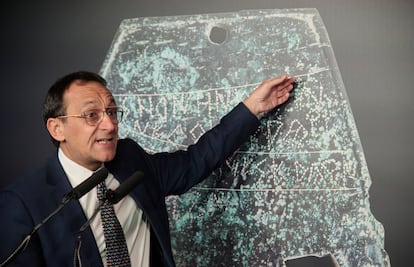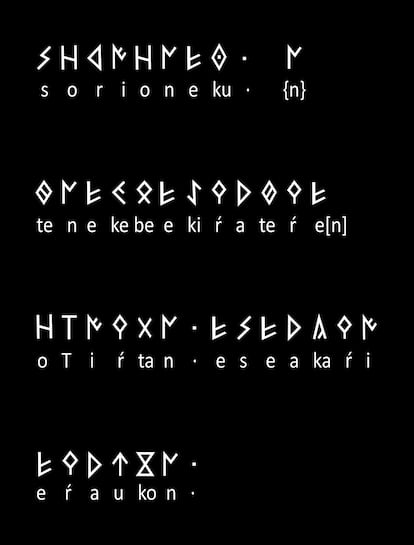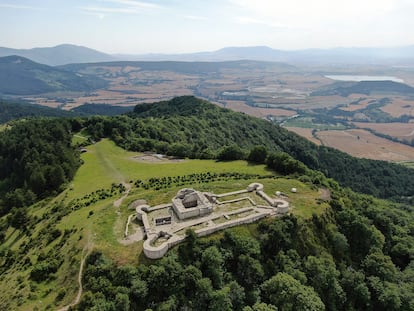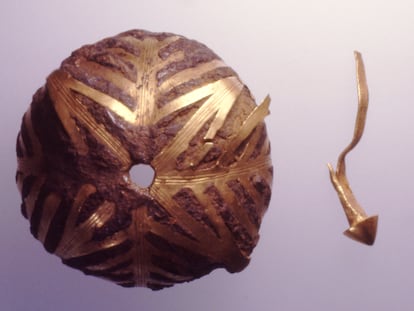What exactly do we know about the Hand of Irulegi?
Experts doubt whether it is a symbol of good fortune or of war. They believe it could include the name of a divinity and confirm that it was written in ‘Basque script’

The Hand of Irulegi is a bronze representation of a right-handed limb dating from the 1st century B.C. On November 14, 2022, in the presence of numerous journalists, this discovery was revealed during excavations at an archaeological site in the valley of Aranguren in the Spanish region of Navarre. The unique object is engraved in Paleo-Hispanic script (a semi-syllabic, rather than alphabetic, script), a first word that specialists soon identified as sorioneku. Given its strong relationship with the present-day Basque language Euskera, it was translated as “good fortune.”
The premiere of the Navarre region, María Chivite, proclaimed it a “historic milestone.” The discovery suggested that an archaic Basque was spoken in Navarre around 2,100 years ago. However, the question is far from clear. Many doubts exist, and perhaps sorioneku could even be the name of a divinity. So what exactly is known?
The Hand of Irulegi is an “exceptional” artifact, of that there is no doubt, according to prominent epigraphers and archaeologists like Mattin Aiestaran, of the Aranzadi Science Society; Joaquín Gorrochategui, of the University of the Basque Country, and Javier Velaza, professor of Latin Philology at the University of Barcelona.
Since the end of the Bronze Age (XV and XI B.C.), the European population started to settle in high places and was therefore better defended against attacks. The Irulegi site is one of these places. Its inhabitants were able to enjoy a broad panoramic view of the surrounding valleys and the routes that led to the Ebro River, the Cantabrian Sea and what was then known as the region of Gaul. The director of the excavations, Mattin Aiestaran, confirmed that the settlement disappeared in the first third of the 1st century B.C., when it was destroyed during the Sertorian Wars (82-72 B.C.), an internal Roman armed conflict. The conflict between the Quintus Sertorius and Gnaeus Pompeius Magnus devastated a large part of the Iberian Peninsula, especially the Ebro Valley. Choosing the wrong side meant total destruction.
The dwelling where the hand was found — known as Building 6000 — contained stone plinths, an adobe elevation and wooden posts to support the wooden or vegetation-covered roof. The metal limb was discovered in the vestibule of the house, among the remains of rust-stained adobe and charred wood. The materials that have been found nearby mainly date from the first quarter of the 1st century B.C., such as coins from the mint of OTtikes (Navarre), ceramics of Campanian import or black varnish, Etruscan productions, burins and various bone elements of fauna. In addition to the hand, two brief ceramic inscriptions were also found.
The hand is a cut bronze sheet (53.19% tin, 40.87% copper and 2.16% lead). On the back, it features the shape of fingernails. In the center, it has a perforation for nailing it to some kind of support. It measures 14.3 centimeters in height and weighs 35.9 grams.
But how was it engraved and by whom? Specialists agree that the first three lines were sketched in a rough and imprecise manner, so that the scribe would stay aligned, something that was not achieved. Then, the scripts were engraved using the sgraffito technique (scratching of the surface layers with a sharp instrument) and later they were marked with the stippling technique following the first sgraffito strokes. This raises the question of whether it was one or two people were involved with its making. “This double procedure is extraordinarily rare in Latin epigraphy as well. In fact, we only know of one example of a silver pátera [a bowl used for ancient sacrifices] from Bourges, France,” says Velaza.
The script used “undoubtedly” belongs to the family of Paleo-Hispanic semi-syllabaries (combination of syllabary and alphabet). Experts note that the text includes a very special feature: a T-shaped sign that was only known in coins from Basque mints, which is why they are in no doubt to designate this written set as belonging to a particular “Basque script.”
This reveals that the ancient Vascones used their own script and not the Iberian one as previously suspected. “The fact that it is an inscription of possibly private character and that it uses a particular graphic system supports the idea of an introduction of the writing in the Vasconic world,” affirm the experts in the recent study. Gorrochategui maintains, therefore, that it is “legitimate” to use the term “Basque” to refer to the inscription.

In ancient societies, writing was learned through contact with other cultures that had already mastered it. In the case of the Vascones, they adopted the Iberian model, but adapted it to their language. From the Celtiberians, they probably copied the use of bronze as a medium for writing, in addition to stippling. They stopped using this type of script, like the rest of the Iberian peoples, in the 1st century B.C., with the extension of the Latin alphabet.
It is not possible to know why the inscription was made on a hand-shaped object, because “such symbolism can cover a wide spectrum: supplication for protection, apotropaic character, expression of friendship or votive offering.” It may even be related to war and not to good fortune, as a severed hand represents victory over enemies, as the Iberians and Lusitanians believed, since they cut off the limbs of their adversaries and hung them on their belts or on the doors of their houses, according to writings of ancient historians Diodorus of Sicily and Strabo.
What does the first sorioneke or sorioneku — depending on whether you read the sgraffito or stippling script — word mean? One thing that is certain is that this word is very similar to the Basque expression zorioneko (lucky, fortunate, of good fortune), which is formed by the words zori (fortune) and (h)on (good).

Another possibility is that sorioneku is an Iberian or Aquitanian language name (a Basque language from the other side of the Pyrenees) made up of the sor or sori particles plus on. Regarding the ending eku, experts find no parallels in Iberian or Aquitanian onomastics. In any case, epigraphers recognize that they have not identified any person’s name on the hand (by comparison with coins or other Iberian texts), and therefore it is likely to be sorioneku.
Javier Velaza explains it as follows: “We have never said that sorioneku was exactly the equivalent of the Basque word zorioneko [fortunate], but that the form sori-on may be equivalent to the Basque zori-on [good fortune].” In addition, as the sgraffito text does not read sorioneku, but rather sorioneke, the eke suffix could be related to a divinity, as is the case in the Basque theonyms Larra-he or Arte-he.
The professor concludes: “This inscription represents a significant contribution to the study of the phenomenon of writing among the Vascones, its adoption and relationship with other Paleo-Hispanic scripts, making it necessary to review all the inscriptions known so far in the region, no matter how fragmentary they may be. Many of the questions raised by the text, such as the value of some signs, can only be answered with more documents, the appearance of which we now know is not unlikely.”
One more question remains to be answered: if the Hand of Irulegi represents the right hand, did anyone in the settlement have the left one?
Sign up for our weekly newsletter to get more English-language news coverage from EL PAÍS USA Edition
Tu suscripción se está usando en otro dispositivo
¿Quieres añadir otro usuario a tu suscripción?
Si continúas leyendo en este dispositivo, no se podrá leer en el otro.
FlechaTu suscripción se está usando en otro dispositivo y solo puedes acceder a EL PAÍS desde un dispositivo a la vez.
Si quieres compartir tu cuenta, cambia tu suscripción a la modalidad Premium, así podrás añadir otro usuario. Cada uno accederá con su propia cuenta de email, lo que os permitirá personalizar vuestra experiencia en EL PAÍS.
¿Tienes una suscripción de empresa? Accede aquí para contratar más cuentas.
En el caso de no saber quién está usando tu cuenta, te recomendamos cambiar tu contraseña aquí.
Si decides continuar compartiendo tu cuenta, este mensaje se mostrará en tu dispositivo y en el de la otra persona que está usando tu cuenta de forma indefinida, afectando a tu experiencia de lectura. Puedes consultar aquí los términos y condiciones de la suscripción digital.
More information
Archived In
Últimas noticias
Most viewed
- Reinhard Genzel, Nobel laureate in physics: ‘One-minute videos will never give you the truth’
- Oona Chaplin: ‘I told James Cameron that I was living in a treehouse and starting a permaculture project with a friend’
- Pablo Escobar’s hippos: A serious environmental problem, 40 years on
- Why we lost the habit of sleeping in two segments and how that changed our sense of time
- Charles Dubouloz, mountaineering star, retires at 36 with a farewell tour inspired by Walter Bonatti











































